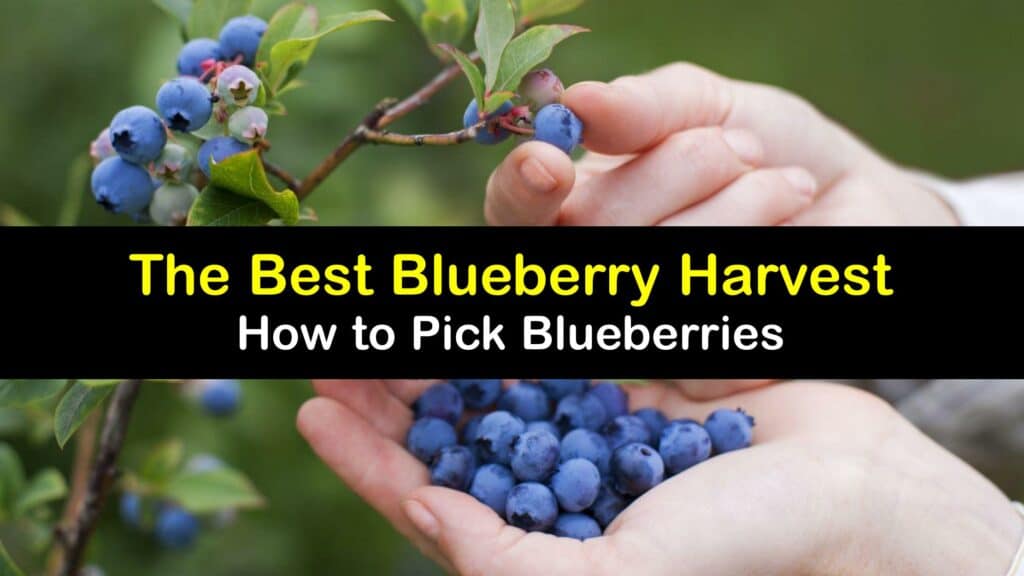Little is more enjoyable than picking organic food from the home garden, and blueberry bushes are one of our favorites. When do blueberry shrubs begin to bear fruit? Learn how long blueberries take to reach maturity and how to harvest blueberries from blueberry plants at the end of the season.
There are four main types of blueberries; lowbush, highbush, hybrid half-high, and rabbiteye. Highbush blueberries are self-fertile, do not require pollination, are disease-resistant, and grow in USDA hardiness zones 4 through 7. Lowbush blueberries (Vaccinium angustifolium) are shorter truer bushes than highbush varieties (Vaccinium corymbosum) and hardy in zones 3 through 6.
Blueberries are an excellent addition to the berry patch, whichever blueberry varieties you grow. The ripe berries are delicious and nutritious, with a higher antioxidant capacity than most other fruits and vegetables. However, avoid picking them the first year to encourage a robust root system.

When and How to Harvest Blueberries
Blueberry bushes are acid-loving plants, relatively easy to grow in the proper soil pH. Blueberry bushes need sun to grow, too, so don’t plant them in shady spots. While they produce flowers and fruits during the first growing season, production is usually sparse. It’s often hard to know when to pick blueberries after planting new plants in the fall, late winter, or early spring.
Discover how long blueberry shrubs take to grow based on the different varieties. Make your own homemade blueberry fertilizer to ensure your plants get the nutrients they need. Learn when and how to harvest blueberries for the best flavor and ways to store your crop after harvesting blueberries.

When to Pick Blueberries
It’s helpful to understand the growth rate of the different blueberry cultivars to know when to pick blueberries so you can eat them. How long does it take for blueberries to grow? Explore how long these plants take to germinate and grow from a root ball or young nursery plant based on plant type.
If planting blueberries from seed, you usually only have to wait about one month before the seedlings emerge. However, there is a longer waiting time for young plants. Lowbush blueberry varieties take two to three years to mature, and highbush types require six to eight years to reach full production.
When to Harvest Blueberries
When are blueberries ready to pick? Find out when to harvest blueberries according to region, berry plant variety, and berry color to ensure you get the juiciest fruits.
Generally, most blueberry types are ready to begin harvesting in mid to late summer. However, rabbiteye blueberries ripen over six weeks, from late May through late July. You can harvest blackberries at the same time as they have a similar growing season.
The region where you live also plays a part in blueberry harvesting. For example, blueberries have a short season in the far south, and harvest time is from mid-March to late May. It’s a good idea to understand your hardiness zone to determine when to harvest blueberries.
Blueberries start light green and gradually turn pink, light blue, and finally dark blue. While it’s tempting to pick the berries as soon as they turn blue, picking them too early results in tart-tasting berries – wait until the entire berry is dark blue before harvesting.
Keep in mind that you’re not the only one who loves eating blueberries. Birds and other critters like eating them as well – placing bird netting over your shrubs while you wait for the berries to mature ensures you get an abundant harvest.
How to Harvest Blueberries
Harvest time is the best part – it’s time to start picking blueberries. Harvest fresh blueberries from your blueberry shrubs and prune the bushes to promote healthy growth. Trimming blueberry branches that are dead encourages new shoots.
Picking blueberries is one of the most straightforward tasks since there isn’t much effort involved. Wait until the berries are entirely blue all the way around and pluck them gently from the stem. Continue picking fresh berries throughout the season as they change from pink and light blue to dark blue.
Prune Blueberry Bushes
Once all the berries are gone, prune your bushes in the late winter to early spring when the plants are dormant and before new shoots emerge. Pruning is essential to maintain an open growth habit, improve air circulation, encourage new, fruit-producing stems, and strengthen blueberry roots.
Prune away any dead or damaged branches, cutting them back to where they join a thicker branch and remove stems that cross each other. Cut a third of the remaining twigs to the ground by removing the oldest and thickest branches.
Ways to Store Blueberries after Harvesting
It’s wise to know how to store fresh fruit after harvesting blueberries to keep them as fresh as possible. Store blueberries for everyday eating or food preservation.
Sort through the berries after harvesting them and remove any stems. If the berries are damp, spread them in a single layer on a baking sheet or cutting board to air dry. Place the dry berries in a storage container with layers of paper towels to prevent moisture build-up, close the lid, and put them in the coldest part of the fridge.
To freeze blueberries for long-term storage, spread them in a single layer on a baking sheet and flash freeze until frozen solid. Pour the frozen blueberries into a freezer bag or container and keep them in the freezer for up to six months.
Blueberries are excellent for home growing, whether you plant a bare-root or nursery plant. However, they love growing in acidic soil, and it’s essential to mulch the dirt or potting mix with pine needles, peat moss, sawdust, or other organic matter if you have alkaline soil.
Give your plants some TLC, and they reward you with fresh berries throughout the summer.

We hope that knowing when and how to harvest blueberries keeps your kitchen well-stock with antioxidant-rich fruits, and we’d love it if you’d share our blueberry harvesting guide with your family and friends on Pinterest and Facebook.